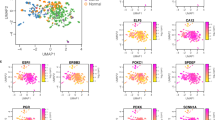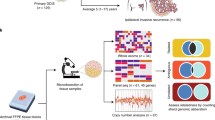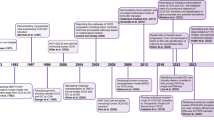Summary
Ninety-eight minimal breast cancers (MBCs) diagnosed between 1975 and 1990, and all originally considered to be invasive were found, on review, to form three groups: (a) 28 predominantly invasive carcinomas ≤10 mm (‘predominant invasive’); (b) 48 predominantly ductal carcinoma in situ (DCIS) lesions with definite foci of invasion each ≤10 mm (‘predominant DCIS’); and (c) 22 DCIS without evidence of invasion (‘pure DCIS’). Tumour histology and immunohistochemical expression of Ki-67, c-erbB2, p53, oestrogen receptor (ER), progesterone receptor (PR), and Bcl-2 were compared. The major finding was the contrasting features in the two invasive groups, with significant differences in their extent of invasion (P < 0.0001), tumour grade (P = 0.03), DCIS type (P = 0.008) and in marker expression. In the predominant invasive group, the infiltrative component was usually greater than 5 mm, low-grade and associated with well-differentiated DCIS. Expression of Ki-67, c-erbB2 and p53 was generally low, and that of ER, PR and Bcl-2 high. The predominant DCIS group in contrast had a much smaller, commonly high-grade, invasive component, usually with poorly differentiated DCIS and the reverse pattern of marker expression. Although not significant, survival of patients in the predominant invasive group was slightly better. These findings suggest that invasive MBCs should perhaps be treated as separate entities, in order to aid more appropriate selection of treatment.
Similar content being viewed by others
Article PDF
Change history
16 November 2011
This paper was modified 12 months after initial publication to switch to Creative Commons licence terms, as noted at publication
References
Ackerman, L. V. & Katzenstein, A. L. (1977). The concept of minimal breast cancer and the pathologist’s role in the diagnosis of ‘early carcinoma’. Cancer 39: 2755–2763.
Allred, D. C., Clark, G. M., Molina, R., Tandon, A. K., Schnitt, S. J., Gilchrist, K. W., Osborne, C. K., Tormey, D. C. & McGuire, W. L. (1992). Overexpression of HER-2/neu and its relationship with other prognostic factors change during the progression of in situ to invasive breast cancer. Hum Pathol 23: 974–979.
Arnesson, L-G, Smeds, S. & Fagerberg, G. (1994). Recurrence-free survival in patients with small breast cancers. An analysis of cancers 10 mm or less detected clinically and by screening. Eur J Surg 160: 271–276.
Barnes, D. M., Bartkova, J., Camplejohn, R. S., Gullick, W. J., Smith, P. J. & Millis, R. R. (1992). Overexpression of the c-erbB-2 oncoprotein: why does this occur more frequently in ductal carcinoma in situ than in invasive mammary carcinoma and is this of prognostic significance?. Eur J Cancer 28: 644–648.
Barnes, D. M., Dublin, E. A., Fisher, C. J., Levison, D. A. & Millis, R. R. (1993). Immunohistochemical detection of p53 protein in mammary carcinoma: an important new independent indicator of prognosis? Hum Pathol 24: 469–476.
Barsky, S. A., Doberneck, S. A., Sternlicht, M. D., Grossman, D. A. & Love, S. M. (1997). ‘Revertant’ DCIS in human axillary breast carcinoma metastases. J Pathol 183: 188–194.
Bartkova, J., Barnes, D. M. & Millis, R. R. (1990). Immunohistochemical demonstration of c-erbB-2 protein in mammary ductal carcinoma in situ. Hum Pathol 21: 1164–1167.
Bellamy, C. O. C., McDonald, C., Salter, D. M., Chetty, U. & Anderson, T. J. (1993). Non-invasive ductal carcinoma of the breast: the relevance of histologic categorization. Hum Pathol 24: 16–23.
Bobrow, L. G., Happerfield, L. C., Gregory, W. M., Springall, R. G. & Millis, R. R. (1994). The classification of ductal carcinoma in situ and its association with biological markers. Semin Diagn Pathol 11: 215–222.
Elston, C. W. & Ellis, I. O. (1991). Pathological prognostic factors in breast cancer. I. The value of histological grade in breast cancer: experience from a large study with long-term follow-up. Histopathology 19: 403–410.
Gallager, H. S. & Martin, J. E. (1971). An orientation to the concept of minimal breast cancer. Cancer 28: 1505–1507.
Goldstein, N. S. & Murphy, T. (1996). Intraductal carcinoma associated with invasive carcinoma of the breast. Am J Clin Pathol 106: 312–318.
Harris, J. R. & Schnitt, S. J. (1990). Is radiotherapy as curative as mastectomy for patients with ductal carcinoma in situ? Int J Radiat Oncol Biol Phys 19: 1091–1092.
Holland, R., Peterse, J. L., Millis, R. R., Eusebi, V., Faverley, D., van de Vijver, M. J. & Zafrani, B. (1994). Ductal carcinoma in situ: a proposal for a new classification. Semin Diagn Pathol 11: 167–180.
Joensuu, H. & Toikkanen, S. (1991). Prognosis of breast cancer with small primary tumor (pT1). Acta Oncol 30: 793–796.
Kaplan, E. L. & Meier, P. (1958). Non-parametic estimation from incomplete observations. Am Stat Assoc J 53: 457–481.
Lagios, M. D., Margolin, F. R., Westdahl, P. R. & Rose, M. R. (1989). Mammographically detected duct carcinoma in situ. Frequency of local recurrence following tylectomy and prognostic effect of nuclear grade on local recurrence. Cancer 63: 618–624.
Lampejo, O. T., Barnes, D. M., Smith, P. & Millis, R. R. (1994). Evaluation of infiltrating carcinomas with a DCIS component: correlation of the histologic type of the in situ component with grade of the infiltrating component. Semin Diagn Pathol 11: 215–222.
Lovekin, C., Ellis, I. O., Locker, A., Robertson, J. F. R., Bell, J., Nicholson, R., Gullick, W. J., Elston, C. W. & Blamey, R. W. (1991). c-erbB-2 oncoprotein expression in primary and advanced breast cancer. Br J Cancer 63: 439–443.
Mack, L., Kerkvliet, N., Doig, G. & O’Malley, F. P. (1997). Relationship of a new histological categorization of ductal carcinoma in situ of the breast with size and the immunohistochemical expression of p53, c-erbB2, bcl-2, and Ki-67. Hum Pathol 28: 974–979.
Millis, R. R. (1996). Classification of ductal carcinoma in situ of the breast. Adv Anat Pathol 3: 114–129.
Millis, R. R., Bobrow, L. G. & Barnes, D. M. (1996). Immunohistochemical evaluation of biological markers in mammary carcinoma in situ: correlation with morphological features and recently proposed schemes for histological classification. Breast 5: 113–122.
Moriya, T. & Silverberg, S. G. (1994). Intraductal carcinoma (ductal carcinoma in situ) of the breast. Cancer 74: 2972–2978.
Mustafa, I., Cole, B., Wanebo, H., Bland, K. & Chang, H. (1998). Prognostic analysis of survival in small breast cancers. J Am Coll Surg 186: 562–569.
Nathan, B., Gusterson, B., Jadayel, D., O’Hare, M., Anbazhagan, R., Jayatilake, H., Ebbs, S., Micklem, K., Gelber, R., Reed, R., Senn, H. J., Goldhirsch, A. & Dyer, M. J. S. (1994). Expression of Bcl-2 in primary breast cancer and its correlation with tumour phenotype. Ann Oncol 5: 409–414.
Patchefsky, A. S., Schwartz, G. F., Finkelstein, S. D., Prestipino, A., Sohn, S. E., Singer, J. S. & Feig, S. (1989). Heterogeneity of intraductal carcinoma of the breast. Cancer 63: 731–741.
Querzoli, P., Albonico, G., Ferretti, S., Rinaldi, R., Beccati, D., Corcione, S., Indelli, M. & Nenci, I. (1998). Modulation of biomarkers in minimal breast carcinoma: a model for human breast carcinoma progression. Cancer 83: 89–97.
Rosner, D. & Lane, W. W. (1990). Node-negative minimal invasive breast cancer patients are not candidates for routine systemic adjuvant therapy. Cancer 66: 199–205.
Schnitt, S. J., Silen, W., Sadowsky, N. L., Connolly, J. L. & Harris, J. R. (1988). Ductal carcinoma in situ (intraductal carcinoma) of the breast. N Engl J Med 318: 898–903.
Scott, M. A., Lagios, M. D., Axelsson, K., Rogers, L. W., Anderson, T. & Page, D. L. (1997). Ductal carcinoma in situ of the breast: reproducibility of histological subtype analysis. Hum Pathol 28: 967–973.
Sinn, H. P., Oelmann, A., Anton, H. W. & Diel, I. J. (1994). Metastatic potential of small and minimally invasive breast carcinomas. Virchows Arch 425: 237–241.
Sobin, L. H. & Wittekind, C. H. (1997). Breast tumours. In TNM Classification of Tumours, Sobin LH & Wittekind CH (eds), pp. 125–127. Wiley Liss: New York.
Tabàr, L., Fagerberg, G., Day, N. E., Duffy, S. W. & Kitchin, R. M. (1992). Breast cancer treatment and natural history: new insights from results of screening. Lancet 339: 412–414.
Tubiana, M. & Koscielny, S. (1991). Natural history of human breast cancer: recent data and clinical implications. Breast Cancer Res Treat 18: 125–140.
van Dongen, J., Holland, R., Peterse, J. L., Fentiman, I. S., Lagios, M. D., Millis, R. R. & Recht, A. (1992). Ductal carcinoma in situ of the breast; second EORTC consensus meeting. Eur J Cancer 28: 626–629.
Veronese, S. M. & Maisano, C. (1996). Comparative prognostic value of Ki-67 and MIB-1 proliferative indices in breast cancer. Anticancer Res 16: 2717–2722.
Author information
Authors and Affiliations
Rights and permissions
From twelve months after its original publication, this work is licensed under the Creative Commons Attribution-NonCommercial-Share Alike 3.0 Unported License. To view a copy of this license, visit http://creativecommons.org/licenses/by-nc-sa/3.0/
About this article
Cite this article
Dublin, E., Millis, R., Smith, P. et al. Minimal breast cancer: evaluation of histology and biological marker expression. Br J Cancer 80, 1608–1616 (1999). https://doi.org/10.1038/sj.bjc.6690570
Received:
Revised:
Accepted:
Published:
Issue date:
DOI: https://doi.org/10.1038/sj.bjc.6690570



